Legal Institutions Assignment 2: Interpretation of Statutes Analysis
VerifiedAdded on 2022/11/25
|9
|2192
|215
Report
AI Summary
This report analyzes the interpretation of statutes within the context of the Good Food Bill 2017. It begins by defining statutory interpretation and outlining key rules, including the literal, golden, mischief, and purpose rules, along with their application. The report then examines three scenarios involving Madge, KK Ltd, and Julian, applying the rules of interpretation to determine potential breaches of the Good Food Bill. Madge, a chef, serves expired food; KK Ltd supplies expired food cans; and Julian offers pastry samples containing aluminum bits. The analysis considers each party's liability under the Bill, highlighting the ambiguity in the legislation and the application of different interpretative approaches. The report concludes that all three parties—Madge, KK Ltd, and Julian—could be held liable under section 4 of the Good Food Bill of 2017. The report references case laws and scholarly articles to support its analysis.
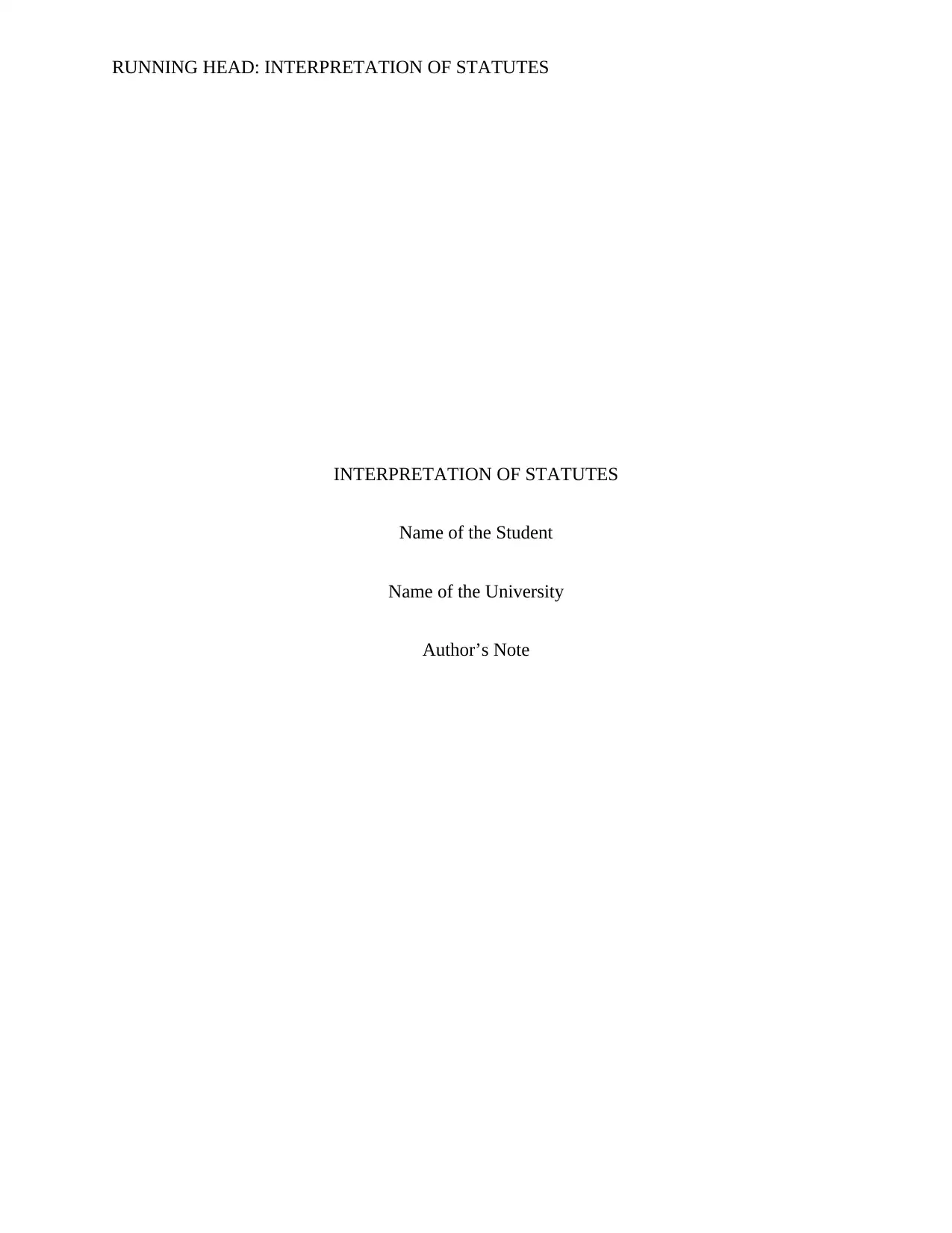
RUNNING HEAD: INTERPRETATION OF STATUTES
INTERPRETATION OF STATUTES
Name of the Student
Name of the University
Author’s Note
INTERPRETATION OF STATUTES
Name of the Student
Name of the University
Author’s Note
Paraphrase This Document
Need a fresh take? Get an instant paraphrase of this document with our AI Paraphraser
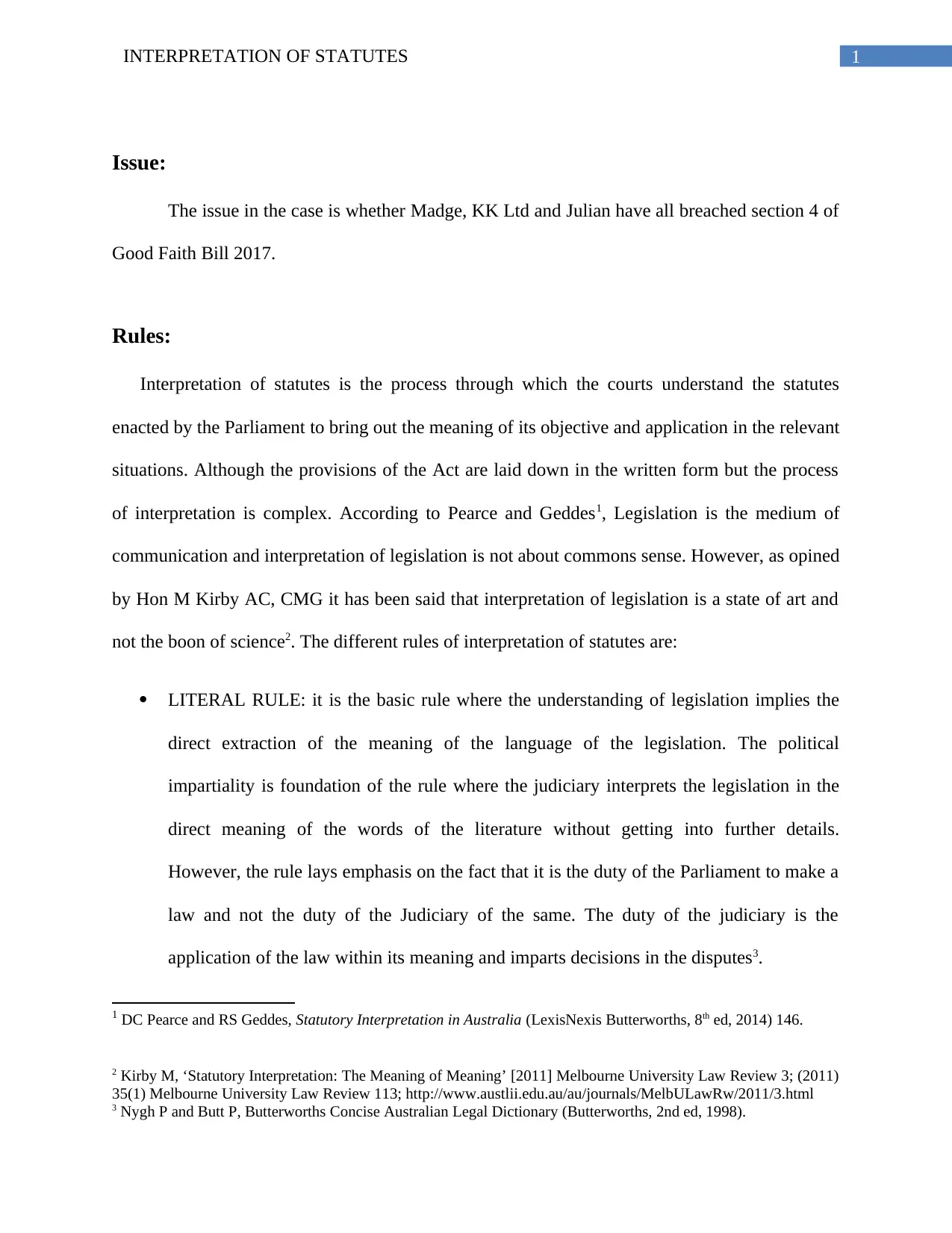
1INTERPRETATION OF STATUTES
Issue:
The issue in the case is whether Madge, KK Ltd and Julian have all breached section 4 of
Good Faith Bill 2017.
Rules:
Interpretation of statutes is the process through which the courts understand the statutes
enacted by the Parliament to bring out the meaning of its objective and application in the relevant
situations. Although the provisions of the Act are laid down in the written form but the process
of interpretation is complex. According to Pearce and Geddes1, Legislation is the medium of
communication and interpretation of legislation is not about commons sense. However, as opined
by Hon M Kirby AC, CMG it has been said that interpretation of legislation is a state of art and
not the boon of science2. The different rules of interpretation of statutes are:
LITERAL RULE: it is the basic rule where the understanding of legislation implies the
direct extraction of the meaning of the language of the legislation. The political
impartiality is foundation of the rule where the judiciary interprets the legislation in the
direct meaning of the words of the literature without getting into further details.
However, the rule lays emphasis on the fact that it is the duty of the Parliament to make a
law and not the duty of the Judiciary of the same. The duty of the judiciary is the
application of the law within its meaning and imparts decisions in the disputes3.
1 DC Pearce and RS Geddes, Statutory Interpretation in Australia (LexisNexis Butterworths, 8th ed, 2014) 146.
2 Kirby M, ‘Statutory Interpretation: The Meaning of Meaning’ [2011] Melbourne University Law Review 3; (2011)
35(1) Melbourne University Law Review 113; http://www.austlii.edu.au/au/journals/MelbULawRw/2011/3.html
3 Nygh P and Butt P, Butterworths Concise Australian Legal Dictionary (Butterworths, 2nd ed, 1998).
Issue:
The issue in the case is whether Madge, KK Ltd and Julian have all breached section 4 of
Good Faith Bill 2017.
Rules:
Interpretation of statutes is the process through which the courts understand the statutes
enacted by the Parliament to bring out the meaning of its objective and application in the relevant
situations. Although the provisions of the Act are laid down in the written form but the process
of interpretation is complex. According to Pearce and Geddes1, Legislation is the medium of
communication and interpretation of legislation is not about commons sense. However, as opined
by Hon M Kirby AC, CMG it has been said that interpretation of legislation is a state of art and
not the boon of science2. The different rules of interpretation of statutes are:
LITERAL RULE: it is the basic rule where the understanding of legislation implies the
direct extraction of the meaning of the language of the legislation. The political
impartiality is foundation of the rule where the judiciary interprets the legislation in the
direct meaning of the words of the literature without getting into further details.
However, the rule lays emphasis on the fact that it is the duty of the Parliament to make a
law and not the duty of the Judiciary of the same. The duty of the judiciary is the
application of the law within its meaning and imparts decisions in the disputes3.
1 DC Pearce and RS Geddes, Statutory Interpretation in Australia (LexisNexis Butterworths, 8th ed, 2014) 146.
2 Kirby M, ‘Statutory Interpretation: The Meaning of Meaning’ [2011] Melbourne University Law Review 3; (2011)
35(1) Melbourne University Law Review 113; http://www.austlii.edu.au/au/journals/MelbULawRw/2011/3.html
3 Nygh P and Butt P, Butterworths Concise Australian Legal Dictionary (Butterworths, 2nd ed, 1998).
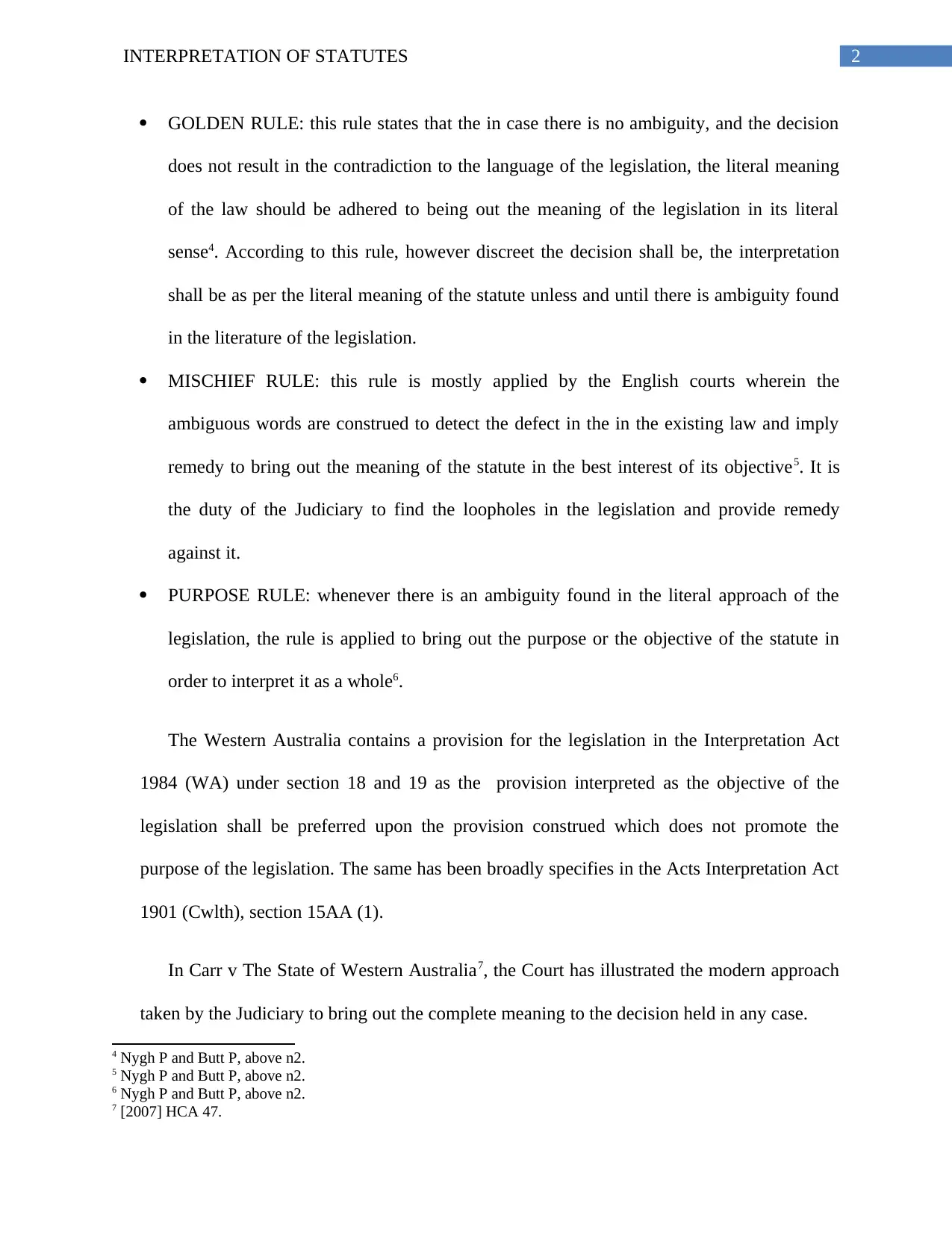
2INTERPRETATION OF STATUTES
GOLDEN RULE: this rule states that the in case there is no ambiguity, and the decision
does not result in the contradiction to the language of the legislation, the literal meaning
of the law should be adhered to being out the meaning of the legislation in its literal
sense4. According to this rule, however discreet the decision shall be, the interpretation
shall be as per the literal meaning of the statute unless and until there is ambiguity found
in the literature of the legislation.
MISCHIEF RULE: this rule is mostly applied by the English courts wherein the
ambiguous words are construed to detect the defect in the in the existing law and imply
remedy to bring out the meaning of the statute in the best interest of its objective5. It is
the duty of the Judiciary to find the loopholes in the legislation and provide remedy
against it.
PURPOSE RULE: whenever there is an ambiguity found in the literal approach of the
legislation, the rule is applied to bring out the purpose or the objective of the statute in
order to interpret it as a whole6.
The Western Australia contains a provision for the legislation in the Interpretation Act
1984 (WA) under section 18 and 19 as the provision interpreted as the objective of the
legislation shall be preferred upon the provision construed which does not promote the
purpose of the legislation. The same has been broadly specifies in the Acts Interpretation Act
1901 (Cwlth), section 15AA (1).
In Carr v The State of Western Australia7, the Court has illustrated the modern approach
taken by the Judiciary to bring out the complete meaning to the decision held in any case.
4 Nygh P and Butt P, above n2.
5 Nygh P and Butt P, above n2.
6 Nygh P and Butt P, above n2.
7 [2007] HCA 47.
GOLDEN RULE: this rule states that the in case there is no ambiguity, and the decision
does not result in the contradiction to the language of the legislation, the literal meaning
of the law should be adhered to being out the meaning of the legislation in its literal
sense4. According to this rule, however discreet the decision shall be, the interpretation
shall be as per the literal meaning of the statute unless and until there is ambiguity found
in the literature of the legislation.
MISCHIEF RULE: this rule is mostly applied by the English courts wherein the
ambiguous words are construed to detect the defect in the in the existing law and imply
remedy to bring out the meaning of the statute in the best interest of its objective5. It is
the duty of the Judiciary to find the loopholes in the legislation and provide remedy
against it.
PURPOSE RULE: whenever there is an ambiguity found in the literal approach of the
legislation, the rule is applied to bring out the purpose or the objective of the statute in
order to interpret it as a whole6.
The Western Australia contains a provision for the legislation in the Interpretation Act
1984 (WA) under section 18 and 19 as the provision interpreted as the objective of the
legislation shall be preferred upon the provision construed which does not promote the
purpose of the legislation. The same has been broadly specifies in the Acts Interpretation Act
1901 (Cwlth), section 15AA (1).
In Carr v The State of Western Australia7, the Court has illustrated the modern approach
taken by the Judiciary to bring out the complete meaning to the decision held in any case.
4 Nygh P and Butt P, above n2.
5 Nygh P and Butt P, above n2.
6 Nygh P and Butt P, above n2.
7 [2007] HCA 47.
⊘ This is a preview!⊘
Do you want full access?
Subscribe today to unlock all pages.

Trusted by 1+ million students worldwide
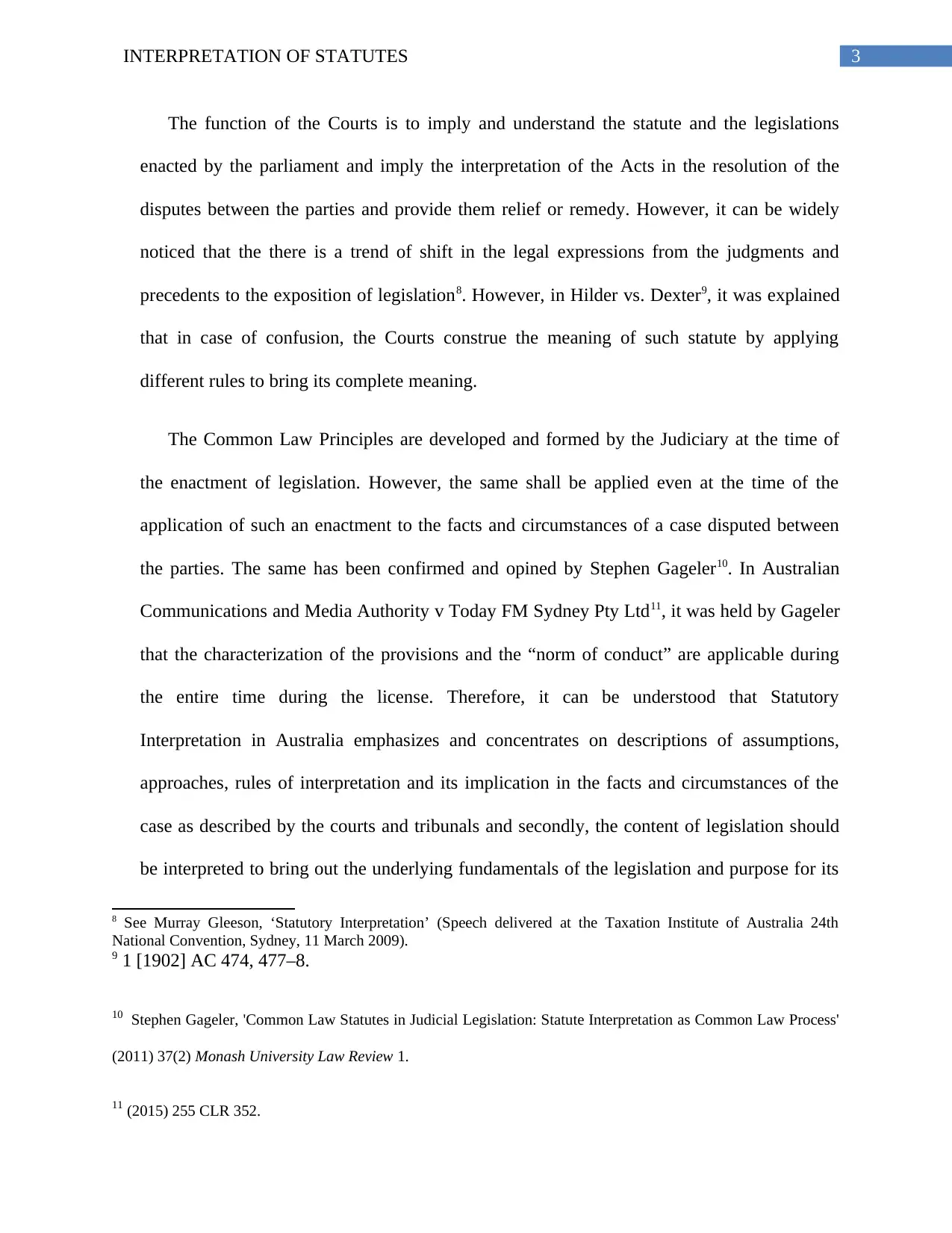
3INTERPRETATION OF STATUTES
The function of the Courts is to imply and understand the statute and the legislations
enacted by the parliament and imply the interpretation of the Acts in the resolution of the
disputes between the parties and provide them relief or remedy. However, it can be widely
noticed that the there is a trend of shift in the legal expressions from the judgments and
precedents to the exposition of legislation8. However, in Hilder vs. Dexter9, it was explained
that in case of confusion, the Courts construe the meaning of such statute by applying
different rules to bring its complete meaning.
The Common Law Principles are developed and formed by the Judiciary at the time of
the enactment of legislation. However, the same shall be applied even at the time of the
application of such an enactment to the facts and circumstances of a case disputed between
the parties. The same has been confirmed and opined by Stephen Gageler10. In Australian
Communications and Media Authority v Today FM Sydney Pty Ltd11, it was held by Gageler
that the characterization of the provisions and the “norm of conduct” are applicable during
the entire time during the license. Therefore, it can be understood that Statutory
Interpretation in Australia emphasizes and concentrates on descriptions of assumptions,
approaches, rules of interpretation and its implication in the facts and circumstances of the
case as described by the courts and tribunals and secondly, the content of legislation should
be interpreted to bring out the underlying fundamentals of the legislation and purpose for its
8 See Murray Gleeson, ‘Statutory Interpretation’ (Speech delivered at the Taxation Institute of Australia 24th
National Convention, Sydney, 11 March 2009).
9 1 [1902] AC 474, 477–8.
10 Stephen Gageler, 'Common Law Statutes in Judicial Legislation: Statute Interpretation as Common Law Process'
(2011) 37(2) Monash University Law Review 1.
11 (2015) 255 CLR 352.
The function of the Courts is to imply and understand the statute and the legislations
enacted by the parliament and imply the interpretation of the Acts in the resolution of the
disputes between the parties and provide them relief or remedy. However, it can be widely
noticed that the there is a trend of shift in the legal expressions from the judgments and
precedents to the exposition of legislation8. However, in Hilder vs. Dexter9, it was explained
that in case of confusion, the Courts construe the meaning of such statute by applying
different rules to bring its complete meaning.
The Common Law Principles are developed and formed by the Judiciary at the time of
the enactment of legislation. However, the same shall be applied even at the time of the
application of such an enactment to the facts and circumstances of a case disputed between
the parties. The same has been confirmed and opined by Stephen Gageler10. In Australian
Communications and Media Authority v Today FM Sydney Pty Ltd11, it was held by Gageler
that the characterization of the provisions and the “norm of conduct” are applicable during
the entire time during the license. Therefore, it can be understood that Statutory
Interpretation in Australia emphasizes and concentrates on descriptions of assumptions,
approaches, rules of interpretation and its implication in the facts and circumstances of the
case as described by the courts and tribunals and secondly, the content of legislation should
be interpreted to bring out the underlying fundamentals of the legislation and purpose for its
8 See Murray Gleeson, ‘Statutory Interpretation’ (Speech delivered at the Taxation Institute of Australia 24th
National Convention, Sydney, 11 March 2009).
9 1 [1902] AC 474, 477–8.
10 Stephen Gageler, 'Common Law Statutes in Judicial Legislation: Statute Interpretation as Common Law Process'
(2011) 37(2) Monash University Law Review 1.
11 (2015) 255 CLR 352.
Paraphrase This Document
Need a fresh take? Get an instant paraphrase of this document with our AI Paraphraser
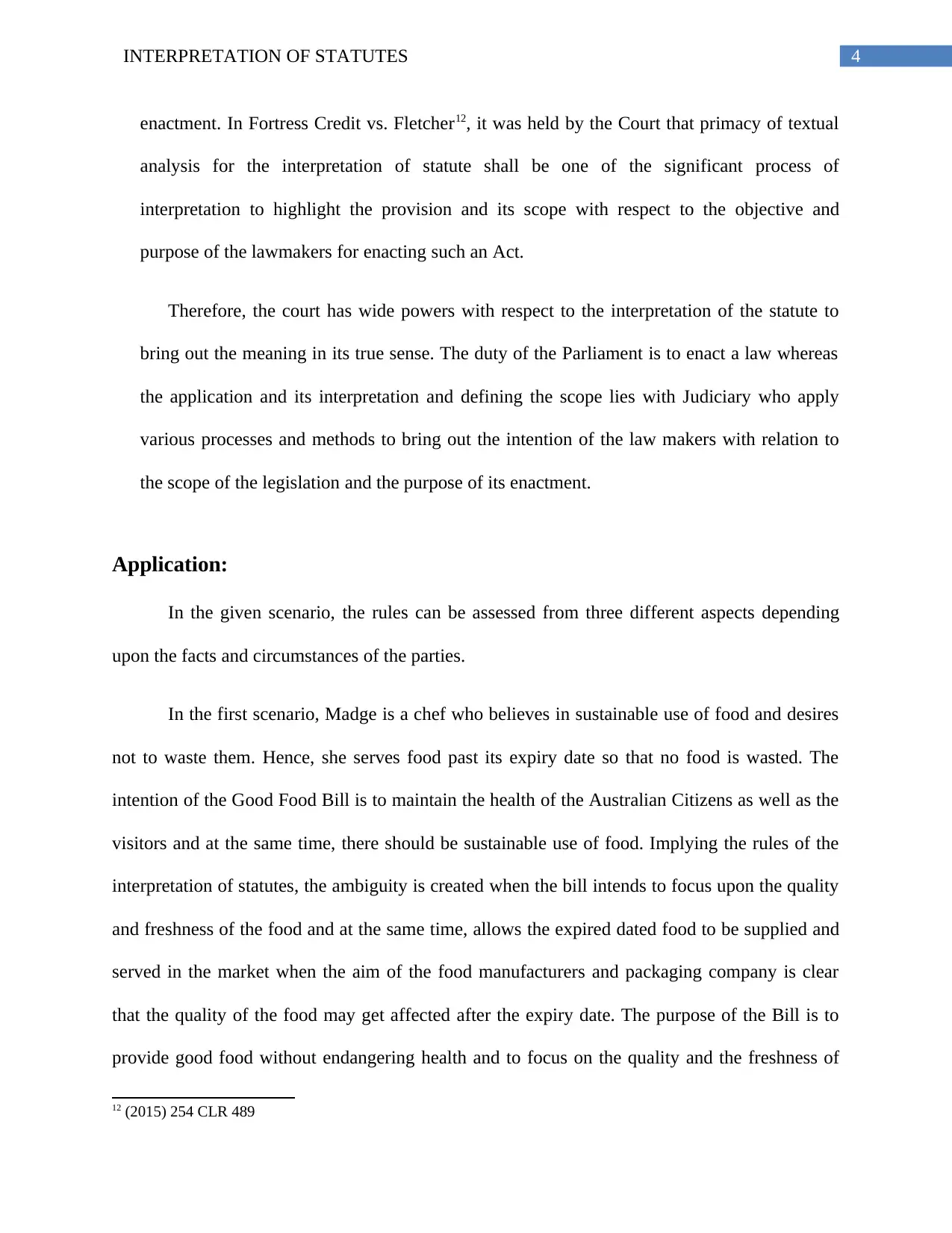
4INTERPRETATION OF STATUTES
enactment. In Fortress Credit vs. Fletcher12, it was held by the Court that primacy of textual
analysis for the interpretation of statute shall be one of the significant process of
interpretation to highlight the provision and its scope with respect to the objective and
purpose of the lawmakers for enacting such an Act.
Therefore, the court has wide powers with respect to the interpretation of the statute to
bring out the meaning in its true sense. The duty of the Parliament is to enact a law whereas
the application and its interpretation and defining the scope lies with Judiciary who apply
various processes and methods to bring out the intention of the law makers with relation to
the scope of the legislation and the purpose of its enactment.
Application:
In the given scenario, the rules can be assessed from three different aspects depending
upon the facts and circumstances of the parties.
In the first scenario, Madge is a chef who believes in sustainable use of food and desires
not to waste them. Hence, she serves food past its expiry date so that no food is wasted. The
intention of the Good Food Bill is to maintain the health of the Australian Citizens as well as the
visitors and at the same time, there should be sustainable use of food. Implying the rules of the
interpretation of statutes, the ambiguity is created when the bill intends to focus upon the quality
and freshness of the food and at the same time, allows the expired dated food to be supplied and
served in the market when the aim of the food manufacturers and packaging company is clear
that the quality of the food may get affected after the expiry date. The purpose of the Bill is to
provide good food without endangering health and to focus on the quality and the freshness of
12 (2015) 254 CLR 489
enactment. In Fortress Credit vs. Fletcher12, it was held by the Court that primacy of textual
analysis for the interpretation of statute shall be one of the significant process of
interpretation to highlight the provision and its scope with respect to the objective and
purpose of the lawmakers for enacting such an Act.
Therefore, the court has wide powers with respect to the interpretation of the statute to
bring out the meaning in its true sense. The duty of the Parliament is to enact a law whereas
the application and its interpretation and defining the scope lies with Judiciary who apply
various processes and methods to bring out the intention of the law makers with relation to
the scope of the legislation and the purpose of its enactment.
Application:
In the given scenario, the rules can be assessed from three different aspects depending
upon the facts and circumstances of the parties.
In the first scenario, Madge is a chef who believes in sustainable use of food and desires
not to waste them. Hence, she serves food past its expiry date so that no food is wasted. The
intention of the Good Food Bill is to maintain the health of the Australian Citizens as well as the
visitors and at the same time, there should be sustainable use of food. Implying the rules of the
interpretation of statutes, the ambiguity is created when the bill intends to focus upon the quality
and freshness of the food and at the same time, allows the expired dated food to be supplied and
served in the market when the aim of the food manufacturers and packaging company is clear
that the quality of the food may get affected after the expiry date. The purpose of the Bill is to
provide good food without endangering health and to focus on the quality and the freshness of
12 (2015) 254 CLR 489
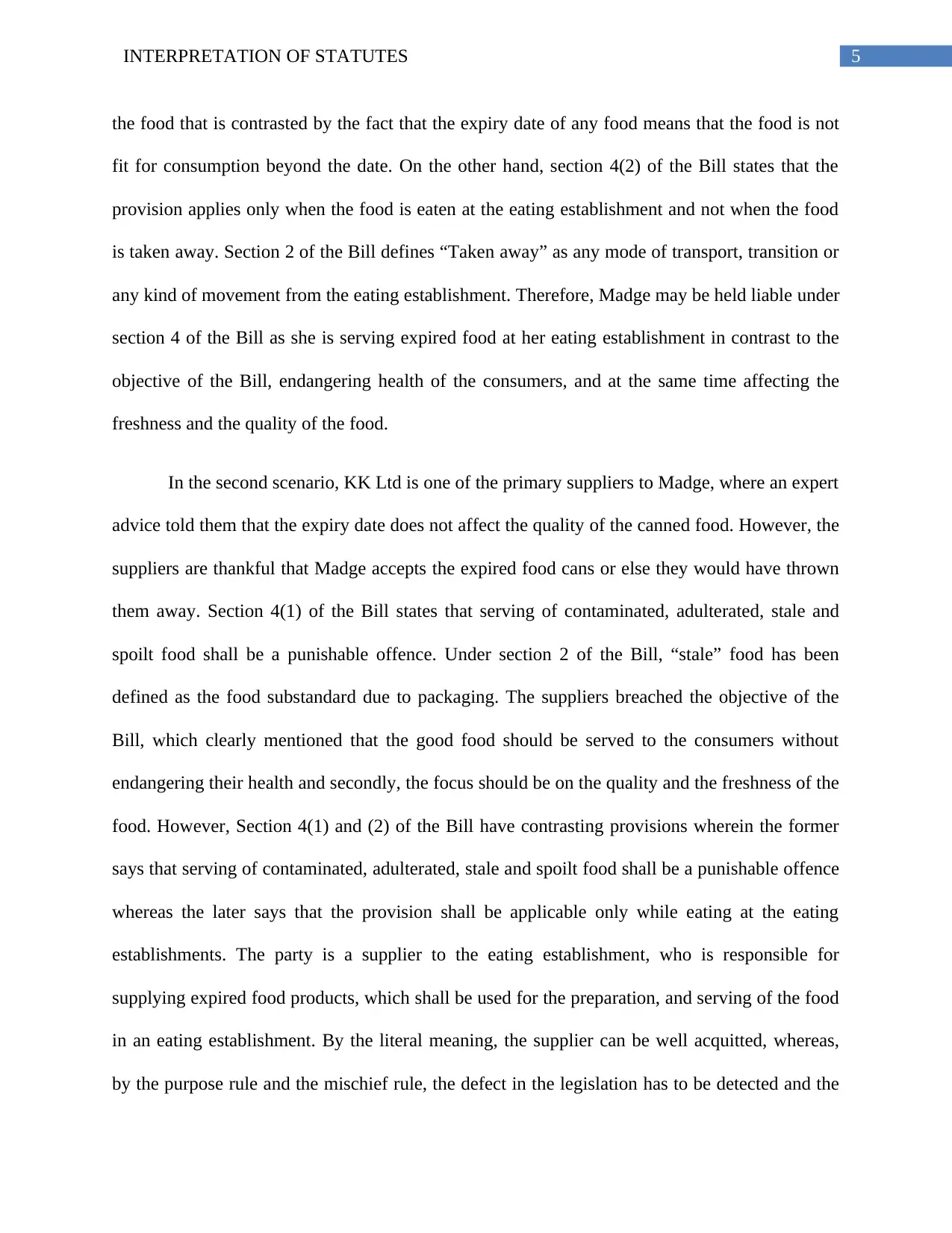
5INTERPRETATION OF STATUTES
the food that is contrasted by the fact that the expiry date of any food means that the food is not
fit for consumption beyond the date. On the other hand, section 4(2) of the Bill states that the
provision applies only when the food is eaten at the eating establishment and not when the food
is taken away. Section 2 of the Bill defines “Taken away” as any mode of transport, transition or
any kind of movement from the eating establishment. Therefore, Madge may be held liable under
section 4 of the Bill as she is serving expired food at her eating establishment in contrast to the
objective of the Bill, endangering health of the consumers, and at the same time affecting the
freshness and the quality of the food.
In the second scenario, KK Ltd is one of the primary suppliers to Madge, where an expert
advice told them that the expiry date does not affect the quality of the canned food. However, the
suppliers are thankful that Madge accepts the expired food cans or else they would have thrown
them away. Section 4(1) of the Bill states that serving of contaminated, adulterated, stale and
spoilt food shall be a punishable offence. Under section 2 of the Bill, “stale” food has been
defined as the food substandard due to packaging. The suppliers breached the objective of the
Bill, which clearly mentioned that the good food should be served to the consumers without
endangering their health and secondly, the focus should be on the quality and the freshness of the
food. However, Section 4(1) and (2) of the Bill have contrasting provisions wherein the former
says that serving of contaminated, adulterated, stale and spoilt food shall be a punishable offence
whereas the later says that the provision shall be applicable only while eating at the eating
establishments. The party is a supplier to the eating establishment, who is responsible for
supplying expired food products, which shall be used for the preparation, and serving of the food
in an eating establishment. By the literal meaning, the supplier can be well acquitted, whereas,
by the purpose rule and the mischief rule, the defect in the legislation has to be detected and the
the food that is contrasted by the fact that the expiry date of any food means that the food is not
fit for consumption beyond the date. On the other hand, section 4(2) of the Bill states that the
provision applies only when the food is eaten at the eating establishment and not when the food
is taken away. Section 2 of the Bill defines “Taken away” as any mode of transport, transition or
any kind of movement from the eating establishment. Therefore, Madge may be held liable under
section 4 of the Bill as she is serving expired food at her eating establishment in contrast to the
objective of the Bill, endangering health of the consumers, and at the same time affecting the
freshness and the quality of the food.
In the second scenario, KK Ltd is one of the primary suppliers to Madge, where an expert
advice told them that the expiry date does not affect the quality of the canned food. However, the
suppliers are thankful that Madge accepts the expired food cans or else they would have thrown
them away. Section 4(1) of the Bill states that serving of contaminated, adulterated, stale and
spoilt food shall be a punishable offence. Under section 2 of the Bill, “stale” food has been
defined as the food substandard due to packaging. The suppliers breached the objective of the
Bill, which clearly mentioned that the good food should be served to the consumers without
endangering their health and secondly, the focus should be on the quality and the freshness of the
food. However, Section 4(1) and (2) of the Bill have contrasting provisions wherein the former
says that serving of contaminated, adulterated, stale and spoilt food shall be a punishable offence
whereas the later says that the provision shall be applicable only while eating at the eating
establishments. The party is a supplier to the eating establishment, who is responsible for
supplying expired food products, which shall be used for the preparation, and serving of the food
in an eating establishment. By the literal meaning, the supplier can be well acquitted, whereas,
by the purpose rule and the mischief rule, the defect in the legislation has to be detected and the
⊘ This is a preview!⊘
Do you want full access?
Subscribe today to unlock all pages.

Trusted by 1+ million students worldwide
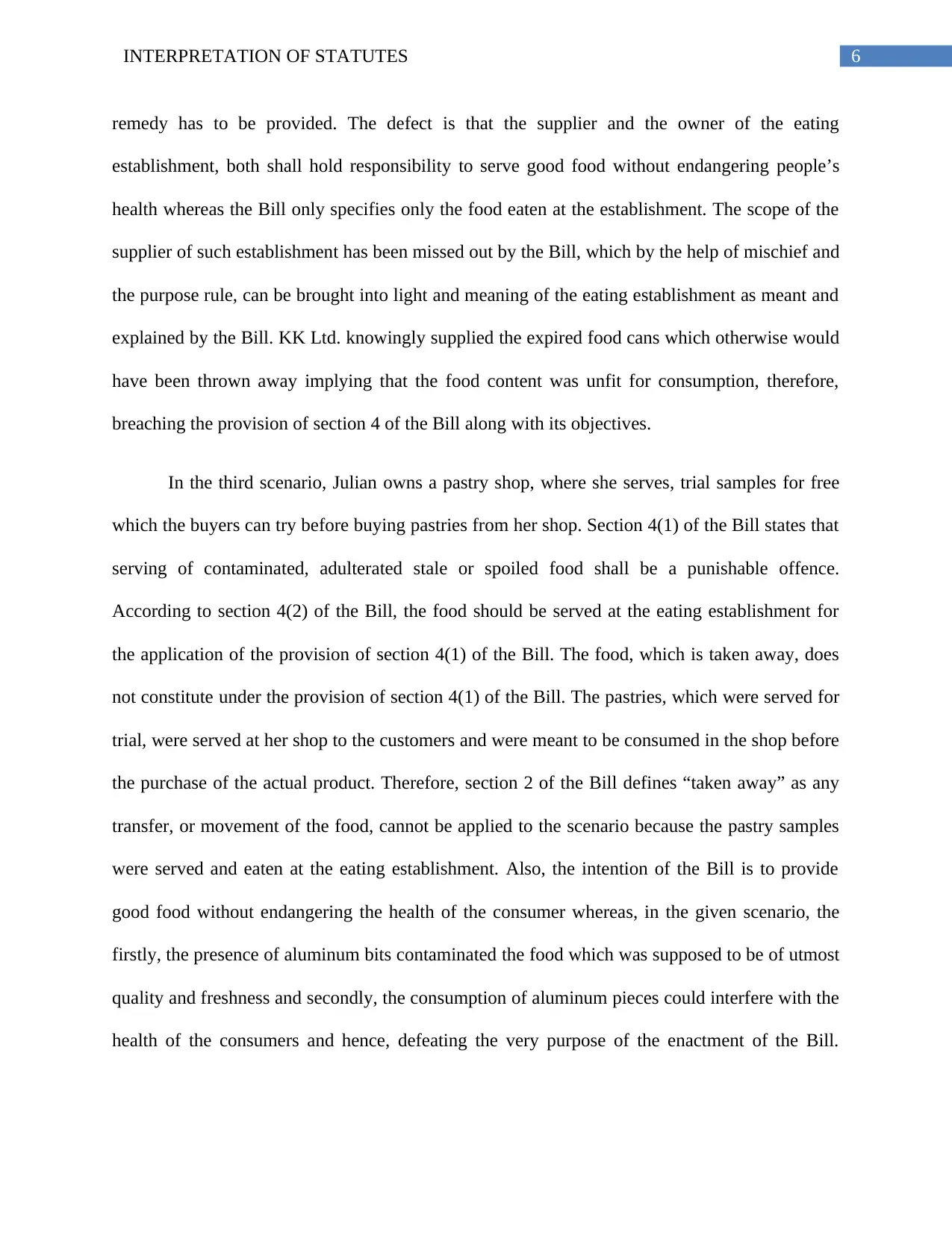
6INTERPRETATION OF STATUTES
remedy has to be provided. The defect is that the supplier and the owner of the eating
establishment, both shall hold responsibility to serve good food without endangering people’s
health whereas the Bill only specifies only the food eaten at the establishment. The scope of the
supplier of such establishment has been missed out by the Bill, which by the help of mischief and
the purpose rule, can be brought into light and meaning of the eating establishment as meant and
explained by the Bill. KK Ltd. knowingly supplied the expired food cans which otherwise would
have been thrown away implying that the food content was unfit for consumption, therefore,
breaching the provision of section 4 of the Bill along with its objectives.
In the third scenario, Julian owns a pastry shop, where she serves, trial samples for free
which the buyers can try before buying pastries from her shop. Section 4(1) of the Bill states that
serving of contaminated, adulterated stale or spoiled food shall be a punishable offence.
According to section 4(2) of the Bill, the food should be served at the eating establishment for
the application of the provision of section 4(1) of the Bill. The food, which is taken away, does
not constitute under the provision of section 4(1) of the Bill. The pastries, which were served for
trial, were served at her shop to the customers and were meant to be consumed in the shop before
the purchase of the actual product. Therefore, section 2 of the Bill defines “taken away” as any
transfer, or movement of the food, cannot be applied to the scenario because the pastry samples
were served and eaten at the eating establishment. Also, the intention of the Bill is to provide
good food without endangering the health of the consumer whereas, in the given scenario, the
firstly, the presence of aluminum bits contaminated the food which was supposed to be of utmost
quality and freshness and secondly, the consumption of aluminum pieces could interfere with the
health of the consumers and hence, defeating the very purpose of the enactment of the Bill.
remedy has to be provided. The defect is that the supplier and the owner of the eating
establishment, both shall hold responsibility to serve good food without endangering people’s
health whereas the Bill only specifies only the food eaten at the establishment. The scope of the
supplier of such establishment has been missed out by the Bill, which by the help of mischief and
the purpose rule, can be brought into light and meaning of the eating establishment as meant and
explained by the Bill. KK Ltd. knowingly supplied the expired food cans which otherwise would
have been thrown away implying that the food content was unfit for consumption, therefore,
breaching the provision of section 4 of the Bill along with its objectives.
In the third scenario, Julian owns a pastry shop, where she serves, trial samples for free
which the buyers can try before buying pastries from her shop. Section 4(1) of the Bill states that
serving of contaminated, adulterated stale or spoiled food shall be a punishable offence.
According to section 4(2) of the Bill, the food should be served at the eating establishment for
the application of the provision of section 4(1) of the Bill. The food, which is taken away, does
not constitute under the provision of section 4(1) of the Bill. The pastries, which were served for
trial, were served at her shop to the customers and were meant to be consumed in the shop before
the purchase of the actual product. Therefore, section 2 of the Bill defines “taken away” as any
transfer, or movement of the food, cannot be applied to the scenario because the pastry samples
were served and eaten at the eating establishment. Also, the intention of the Bill is to provide
good food without endangering the health of the consumer whereas, in the given scenario, the
firstly, the presence of aluminum bits contaminated the food which was supposed to be of utmost
quality and freshness and secondly, the consumption of aluminum pieces could interfere with the
health of the consumers and hence, defeating the very purpose of the enactment of the Bill.
Paraphrase This Document
Need a fresh take? Get an instant paraphrase of this document with our AI Paraphraser
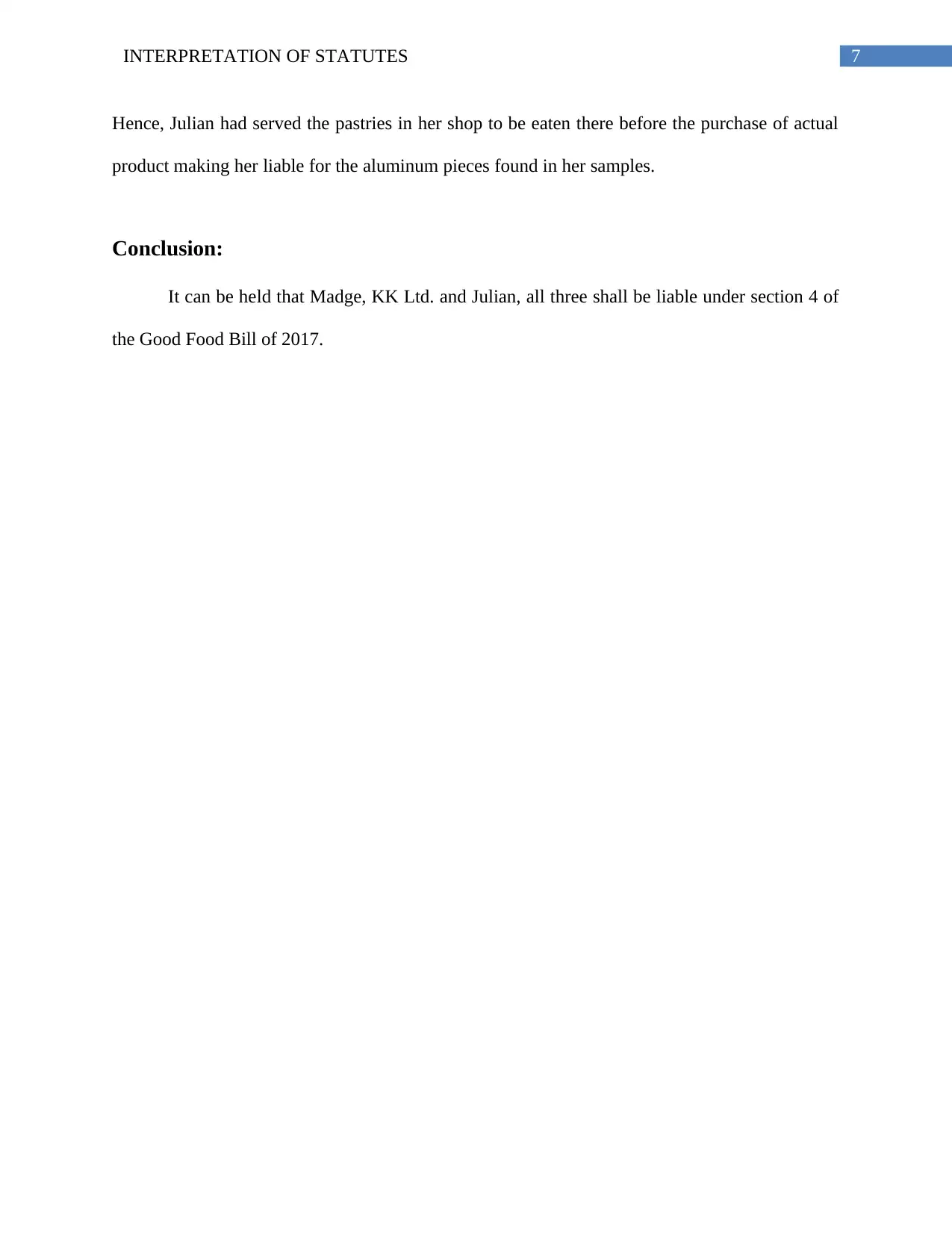
7INTERPRETATION OF STATUTES
Hence, Julian had served the pastries in her shop to be eaten there before the purchase of actual
product making her liable for the aluminum pieces found in her samples.
Conclusion:
It can be held that Madge, KK Ltd. and Julian, all three shall be liable under section 4 of
the Good Food Bill of 2017.
Hence, Julian had served the pastries in her shop to be eaten there before the purchase of actual
product making her liable for the aluminum pieces found in her samples.
Conclusion:
It can be held that Madge, KK Ltd. and Julian, all three shall be liable under section 4 of
the Good Food Bill of 2017.
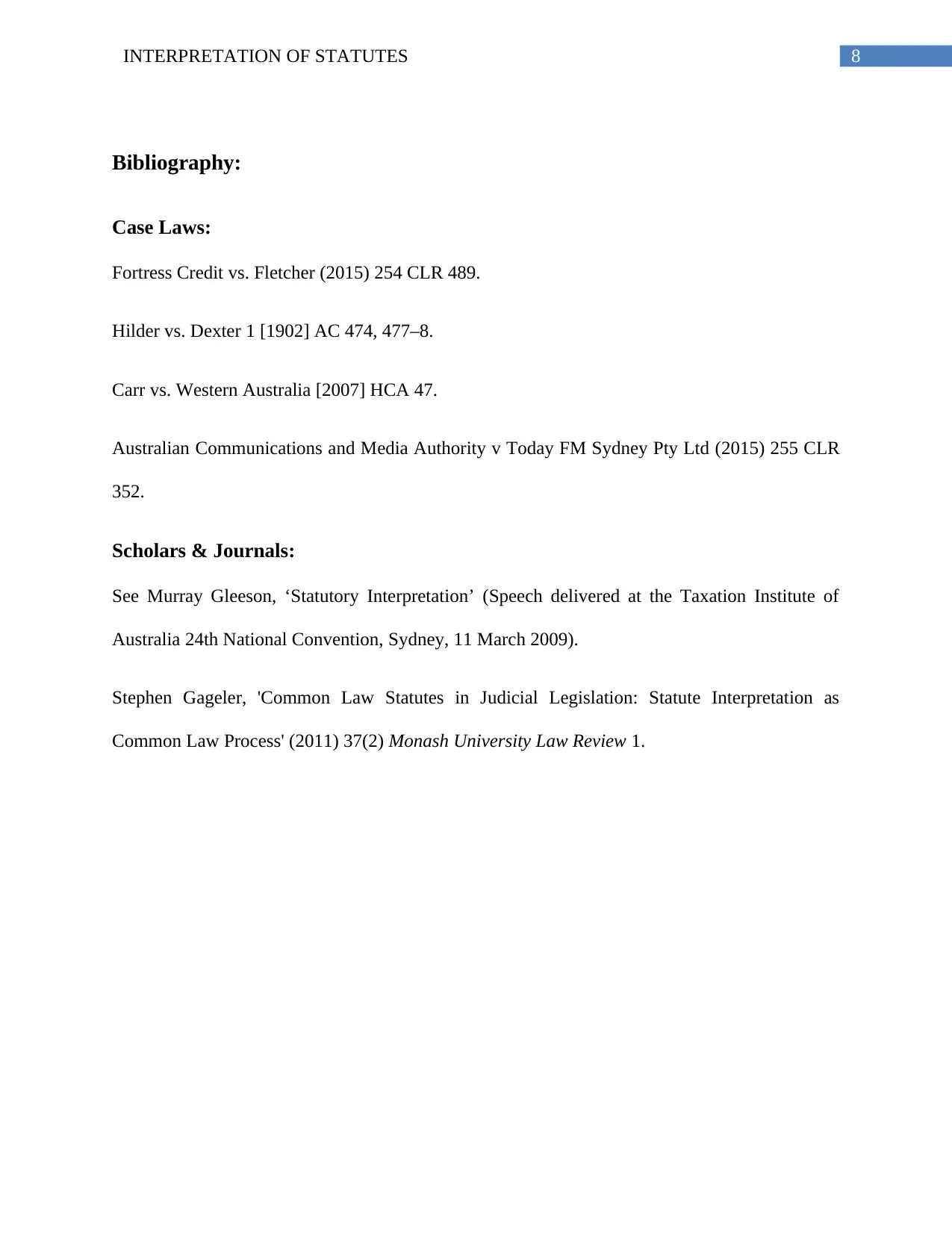
8INTERPRETATION OF STATUTES
Bibliography:
Case Laws:
Fortress Credit vs. Fletcher (2015) 254 CLR 489.
Hilder vs. Dexter 1 [1902] AC 474, 477–8.
Carr vs. Western Australia [2007] HCA 47.
Australian Communications and Media Authority v Today FM Sydney Pty Ltd (2015) 255 CLR
352.
Scholars & Journals:
See Murray Gleeson, ‘Statutory Interpretation’ (Speech delivered at the Taxation Institute of
Australia 24th National Convention, Sydney, 11 March 2009).
Stephen Gageler, 'Common Law Statutes in Judicial Legislation: Statute Interpretation as
Common Law Process' (2011) 37(2) Monash University Law Review 1.
Bibliography:
Case Laws:
Fortress Credit vs. Fletcher (2015) 254 CLR 489.
Hilder vs. Dexter 1 [1902] AC 474, 477–8.
Carr vs. Western Australia [2007] HCA 47.
Australian Communications and Media Authority v Today FM Sydney Pty Ltd (2015) 255 CLR
352.
Scholars & Journals:
See Murray Gleeson, ‘Statutory Interpretation’ (Speech delivered at the Taxation Institute of
Australia 24th National Convention, Sydney, 11 March 2009).
Stephen Gageler, 'Common Law Statutes in Judicial Legislation: Statute Interpretation as
Common Law Process' (2011) 37(2) Monash University Law Review 1.
⊘ This is a preview!⊘
Do you want full access?
Subscribe today to unlock all pages.

Trusted by 1+ million students worldwide
1 out of 9
Related Documents
Your All-in-One AI-Powered Toolkit for Academic Success.
+13062052269
info@desklib.com
Available 24*7 on WhatsApp / Email
![[object Object]](/_next/static/media/star-bottom.7253800d.svg)
Unlock your academic potential
Copyright © 2020–2025 A2Z Services. All Rights Reserved. Developed and managed by ZUCOL.





